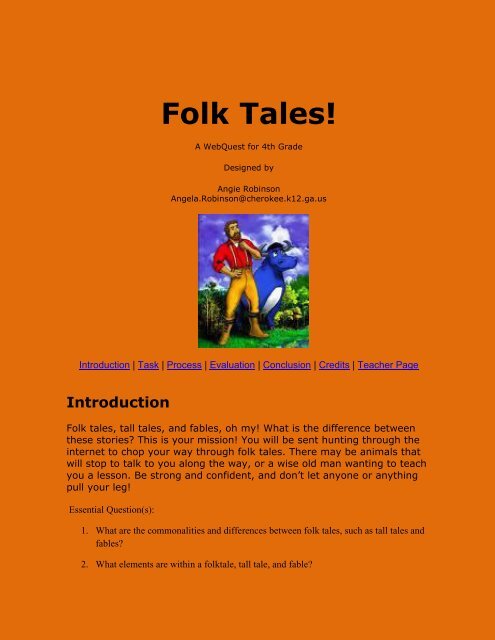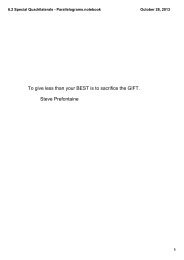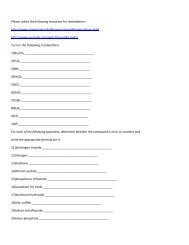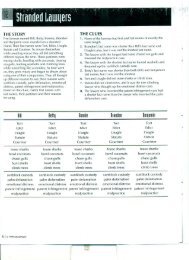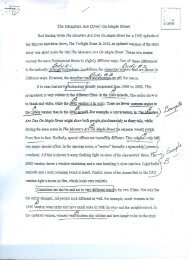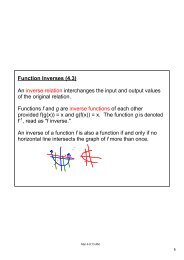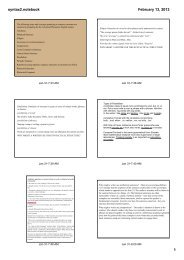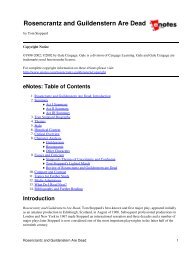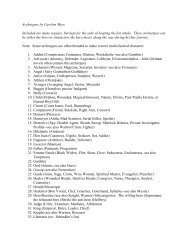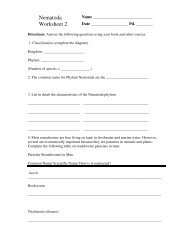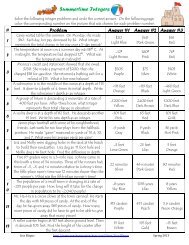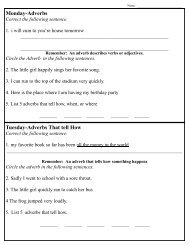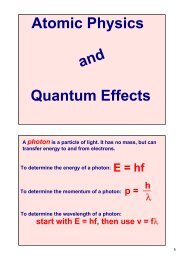Tall Tales Webquest - Cherokee County Schools
Tall Tales Webquest - Cherokee County Schools
Tall Tales Webquest - Cherokee County Schools
Create successful ePaper yourself
Turn your PDF publications into a flip-book with our unique Google optimized e-Paper software.
Folk <strong>Tales</strong>!<br />
A WebQuest for 4th Grade<br />
Designed by<br />
Angie Robinson<br />
Angela.Robinson@cherokee.k12.ga.us<br />
Introduction | Task | Process | Evaluation | Conclusion | Credits | Teacher Page<br />
Introduction<br />
Folk tales, tall tales, and fables, oh my! What is the difference between<br />
these stories? This is your mission! You will be sent hunting through the<br />
internet to chop your way through folk tales. There may be animals that<br />
will stop to talk to you along the way, or a wise old man wanting to teach<br />
you a lesson. Be strong and confident, and don’t let anyone or anything<br />
pull your leg!<br />
Essential Question(s):<br />
1. What are the commonalities and differences between folk tales, such as tall tales and<br />
fables?<br />
2. What elements are within a folktale, tall tale, and fable?
3. How do these stories teach a lesson that can be related to our everyday lives?<br />
4. How can we create our own stories to teach a moral lesson?<br />
The Task<br />
Students, your first mission is to complete a scavenger hunt through the internet to<br />
learn as much as you can about the subject in question. Then you will use that<br />
knowledge to design your own story that is a fable. You will use this story to<br />
design your film, which can be created through claymation, or a film with your<br />
classmates as actors in your play. You will have a chance to take your creation into<br />
movie maker or adobe premier and add special effects and credits.<br />
The Process<br />
Mission #1 The Scavenger Hunt<br />
Directions: Read each question carefully and click on the website link. You<br />
must read the story on the website and answer the questions from the<br />
scavenger hunt. (I have printed a copy of this scavenger hunt out for you<br />
to fill in!)<br />
1. In this <strong>Tall</strong> Tale, Paul Bunyan could holler so loud he scared all the _______ out of<br />
the rivers and streams.<br />
http://www.americanfolklore.net/folktales/me5.html<br />
2. In this <strong>Tall</strong> Tale, Pecos Bill was only known to have been thrown once in his whole<br />
cowboy career. That was when he was riding a ___________.<br />
http://www.americanfolklore.net/folktales/ks2.html<br />
3. In this Fable, what should the farmer and his wife do the next time they hear a rooster<br />
trying to wake them up?
What might happen again if they don’t get up?<br />
http://www.americanfolklore.net/folktales/ga.html<br />
4. In the folk tale “Coyote and the Columbia” why was the Columbia River created?<br />
http://www.americanfolklore.net/folktales/wa.html<br />
5. Choose story #3 “Rainbow of the Sioux.” Listen to the small portion of the story and<br />
write a couple of sentences with exaggeration (hyperboles) of what you think will<br />
happen next.<br />
http://www.talltalesaudio.com/<br />
6. In the fable, “The Fox and the Grapes” who was the smartest, the farmer or the fox?<br />
What in the story makes you think that?<br />
http://www.pitara.com/talespin/folktales/online.asp?story=32<br />
7. Name 3 exaggerations from this small story of Paul Bunyan:<br />
http://www.paulbunyantrail.com/page2.html<br />
8. Listen to the story and list 3 new exaggerations you learned about Paul Bunyan.<br />
http://www.animatedtalltales.com/flash/story/<br />
9. Read “The Basics” What is the major element of a <strong>Tall</strong> Tale?<br />
http://42explore.com/talltale.htm<br />
10. John Henry tried to beat the steam drill with only a ________ in his hand.<br />
http://www.ibiblio.org/john_henry/early.html<br />
11. What lesson did the grasshopper learn in the fable, “The Ant and the
Grasshopper?”<br />
http://www.umass.edu/aesop/content.php?n=0&i=1<br />
12. How is a fable different from a tall tale? Use all the information you have<br />
learned from the searches you did above. If you need help you can look the words up<br />
at www.dictionary.com.<br />
13. What is a Folk Tale?<br />
www.dictionary.com<br />
Mission #2 Writing Your Own Story<br />
Now that you have done your research, you should know that folk tales have been<br />
passed down from generation to generation, mostly through stories told orally.<br />
Fables are a special part of folk tales because they are meant to teach a lesson.<br />
Now it is your turn to teach the generations that come after you. You must think of<br />
an important lesson that you think all students must know. Since you are fourth<br />
graders, it is important to help the students that come to your school to know the<br />
important things to help them survive their elementary years.<br />
Make sure you include animal characters (No more than 3)!<br />
What problem would your characters face?<br />
There must be a trickster in the story that leads to the moral lesson.<br />
The problem must be solved.<br />
The moral lesson must be stated at the end.<br />
Hint: Create the moral first and then your story around it! Make sure this is written
in a play format, and continuously check the rubric below to make sure you have<br />
everything you need.<br />
Mission #3 Producing your Story<br />
Tier 1<br />
If you choose Tier 1, you will be taking your play and gathering friends to be<br />
actors in your play. When you are finished you will download your movie from<br />
your flip camera onto movie maker and adding your credits, etc.<br />
Step 1: Determine which classmates would be best for your play, and ask them<br />
if they would like to be a part of your act.<br />
Step 2: Give each classmate a copy of your script and practice where you want<br />
them to stand and practice voice projection. You will be filming the play so you<br />
can not be in the play!<br />
Step 3: Gather together costumes and props you will need. Meet with your<br />
teacher to see what she can provide and what you will need to bring. Create any<br />
props or scenery you will need.<br />
Step 4: Make sure all your costumes and props are ready the day before filming<br />
so you can have a dress rehearsal.<br />
Step 5: You will use a flip camera to film the movie.<br />
Step 6: When you are finished filming you will download your movie to movie<br />
maker and save on a thumb drive.<br />
Step 7: Now it is time for editing! First, create a title page with a title and<br />
author.<br />
Step 8: You can add music from soundzabound for the introduction and the
credits at the end.<br />
Step 9: Add a credits page at the end with your actor’s names and thanking<br />
anyone who helped you in creating your film.<br />
Hint: Be sure to save your work often!!!<br />
Tier 2<br />
For Tier 2, you will be creating your story with claymation. When you are finished<br />
filming with your web camera you will download your movie to movie maker to<br />
add music, credits, etc.<br />
Step 1: Determine if you will need a partner to help in manipulating your<br />
characters.<br />
Step 2: Decide if you will do a voice over, for the story or will you have<br />
different slide come into your film to tell the story.<br />
Step 3: Gather materials you will need to create your characters and scenery.<br />
Meet with your teacher to see what she can provide and what you will need to<br />
bring. Create any props or scenery you will need.<br />
Step 4: Make sure all your props are ready the day before filming so you can<br />
have a dress rehearsal. You may need practice filming a couple of times to get the<br />
timing correct.<br />
Step 5: You will use a web camera to film the movie. You may need to record<br />
your voice if you are doing the voices.<br />
Step 6: When you are finished filming you will download your movie to movie<br />
maker and save on a thumb drive.<br />
Step 7: Now it is time for editing! First, create a title page with a title and<br />
author.<br />
Step 8: You can add music from soundzabound for the introduction and the<br />
credits at the end.<br />
Step 9: Add a credits page at the end with your actor’s names and thanking
anyone who helped you in creating your film.<br />
Hint: Be sure to save your work often!!!<br />
Tier 3<br />
This Tier also involves using your classmates as characters in your play. However,<br />
instead of using movie maker for editing, you will use Adobe Premier for special<br />
effects.<br />
Step 1: Determine which classmates would be best for your play, and ask them if<br />
they would like to be a part of your act.<br />
Step 2: Give each classmate a copy of your script and practice where you want<br />
them to stand and practice voice projection. You will be filming the play so you<br />
can not be in the play!<br />
Step 3: Gather together costumes and props you will need. Meet with your<br />
teacher to see what she can provide and what you will need to bring. Create any<br />
props or scenery you will need. Keep in mind you could use a green screen effect<br />
for your movie. To do that we will need to plan ahead to put up the green screen<br />
and make sure the costumes don’t blend with it. There should be a lot of movement<br />
with your characters either.<br />
Step 4: Make sure all your costumes and props are ready the day before filming<br />
so you can have a dress rehearsal.<br />
Step 5: You will use a flip camera to film the movie.<br />
Step 6: When you are finished filming you will download your movie to Adobe<br />
Premier and save on a thumb drive.<br />
Step 7: Now it is time for editing! First, create a title page with a title and<br />
author. You can use the effects from Adobe that can add already created<br />
introductions with applause and credits pages.<br />
Step 8: You can add music from soundzabound for the introduction and the<br />
credits at the end.<br />
Step 9: Add a credits page at the end with your actor’s names and thanking<br />
anyone who helped you in creating your film.
Step 10: Add any other needed special effects between scenes or green screen<br />
effects.<br />
Hint: Be sure to save your work often!!!<br />
Evaluation<br />
Now it is time to grade your story. Make sure you read through all the<br />
Exemplary boxes to make sure your have included everything. You must<br />
turn your story in to your teacher, and if you score in the accomplished or<br />
exemplary columns then you can begin Mission #3!<br />
CATEGORY 4 Exemplary 3 Accomplished 2 Approaching 1 Needs More<br />
Characters<br />
Problem<br />
Solution to<br />
Problem in<br />
Story<br />
The main characters<br />
are named and<br />
clearly described<br />
(through words<br />
and/or actions). The<br />
audience knows and<br />
can describe what<br />
the characters look<br />
like and how they<br />
typically behave, and<br />
they are animals.<br />
It is very easy for the<br />
audience to<br />
understand what<br />
problem the main<br />
character(s) face<br />
and why it is a<br />
problem.<br />
The solution to the<br />
problem is easy-tounderstand<br />
and is<br />
logical. There are no<br />
loose ends.<br />
The main characters<br />
are named and<br />
described (through<br />
words and/or<br />
actions). The<br />
audience has a fairly<br />
good idea of what<br />
the characters look<br />
like, and they are<br />
animals.<br />
It is fairly easy for<br />
the audience to<br />
understand what<br />
problem the main<br />
character(s) face<br />
and why it is a<br />
problem.<br />
The solution to the<br />
problem is easy-tounderstand<br />
and is<br />
somewhat logical.<br />
The main characters<br />
are named. The<br />
audience knows very<br />
little about the main<br />
characters.<br />
It is fairly easy for<br />
the audience to<br />
understand what<br />
problem the main<br />
character(s) face<br />
and but it is not clear<br />
why it is a problem.<br />
The solution to the<br />
problem was a little<br />
hard to understand.<br />
It is hard to tell who<br />
the main characters<br />
are.<br />
It is not clear what<br />
problem the main<br />
character(s) face.<br />
No solution was<br />
attempted or it was<br />
impossible to<br />
understand.
Moral Lesson<br />
Trickster<br />
Conclusion<br />
The moral lesson is<br />
clearly stated and<br />
one character<br />
teaches the other<br />
through the problem,<br />
solution, and trick.<br />
One character tricks<br />
another to help teach<br />
the moral lesson,<br />
and it is easily<br />
identified in the<br />
story.<br />
The moral lesson is<br />
stated through the<br />
problem and<br />
solution.<br />
One character tricks<br />
another to help teach<br />
the moral lesson.<br />
The moral lesson is<br />
stated, and is<br />
starting to be<br />
developed.<br />
One character tricks<br />
another, and it is<br />
easily identified in<br />
the story.<br />
Score<br />
The moral lesson is<br />
stated, but is not<br />
shown in the story.<br />
One character tricks<br />
another character.<br />
Now that you are well versed in Folk <strong>Tales</strong>, writing plays, and now<br />
producing your own movies, you can always go forward and try some tall<br />
tales on your own. They can be a lot of fun and full of exaggeration. Look<br />
at the link below for some sample plays.<br />
http://www.aaronshep.com/stories/index.html<br />
Credits & References<br />
Thank you to all the websites listed on this WebQuest. This is meant<br />
strictly for educational purposes.<br />
A special thank you to Jim Berry and Merry Willis for your wealth of<br />
knowledge in technology and movie making!<br />
Last updated on August 15, 1999. Based on a template from The WebQuest Page


